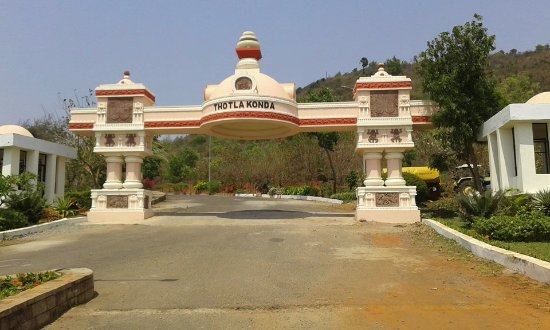Thotlakonda - A Budhist Complex:

Thotlakonda - A Buddhist Complex is situated on a hill near Bheemunipatnam about 15 kilometres (9.3 mi) from Visakhapatnam in Andhra Pradesh, India. The hill is about 128 metres (420 ft) above sea level and overlooks the sea. The Telugu name Toṭlakoṇḍa derived from the presence of a number of rock-cut cisterns hewn into the bedrock of the hillock.
Thotlakonda was well within the influence of ancient Kalinga, which was an important source of dissemination of Buddhism to Sri Lanka and various parts of Southeast Asia. It provides an insight into the process of transoceanic diffusion of Indic culture, especially Buddhism.
A hill on the sea coast with salubrious climate was an ideal attraction for the Buddhist monks to build a monastery complex here. The placid sea sheltered by the deeply in curved coastline here, provided a safe haven for anchoring ships.
Thotlakonda came to light during an aerial survey by the Indian Navy for setting up a Naval Base. After its discovery, major excavations have been conducted by the Andhra Pradesh State Archaeology Department during 1988 - 1993. The excavations established the existence of a Hinayana Buddhist complex which flourished 2000 years ago. To the South of the complex there is a tank which served as a water source to the inhabitants of the monastery.
The excavations reveal Satavahana dynasty lead and Roman silver coins indicating foreign trade; terracotta tiles, stucco decorative pieces, sculptured panels, miniature stupa models in stone, and Buddha footprints were also found. The excavations also yielded twelve inscriptions in the Brahmi script. From polygraphic studies, it appears that the hill might have been known as Senagiri; Senain Pali means "elder, superior".
Thotlakonda's peak activity was between the 2nd century BC and the 2nd century owing to brisk Roman trade and religious missions sent abroad. Thotlakonda came into existence along with nearby sites in Visakhapatnam like Bavikonda and Pavurallakonda. The lofty stupas shining during the day, with their light lime plaster and with rows of wick lamps during nights, might have served as guiding landmarks of nautical commuters. There appears to have been no royal patronage for this monastery. However traders and local believers seem to have supported the complex. In its heyday, Thotlakonda might have accommodated more than 100 bhikkhus.
The complex had arrangements for storing food, clothing, medicines and served as a religious cum academic centre. Nikaya Buddhism appears to have been practiced here, including the worship of Gautama Buddha through symbols such as padukas and other material remains rather than using human representation.
Entry Fee:
Film shooting/TV Serials : Rs.6000/- + GST 18%
Entry fee for Pedestrians : Rs.5/-
Parking Fee:
2 wheelers : Rs.20/- ; Cars: Rs.30/-
Big Bus : RS.300/- ; Mini Bus : Rs.150/-
Adult and Child Walkers : 5/-